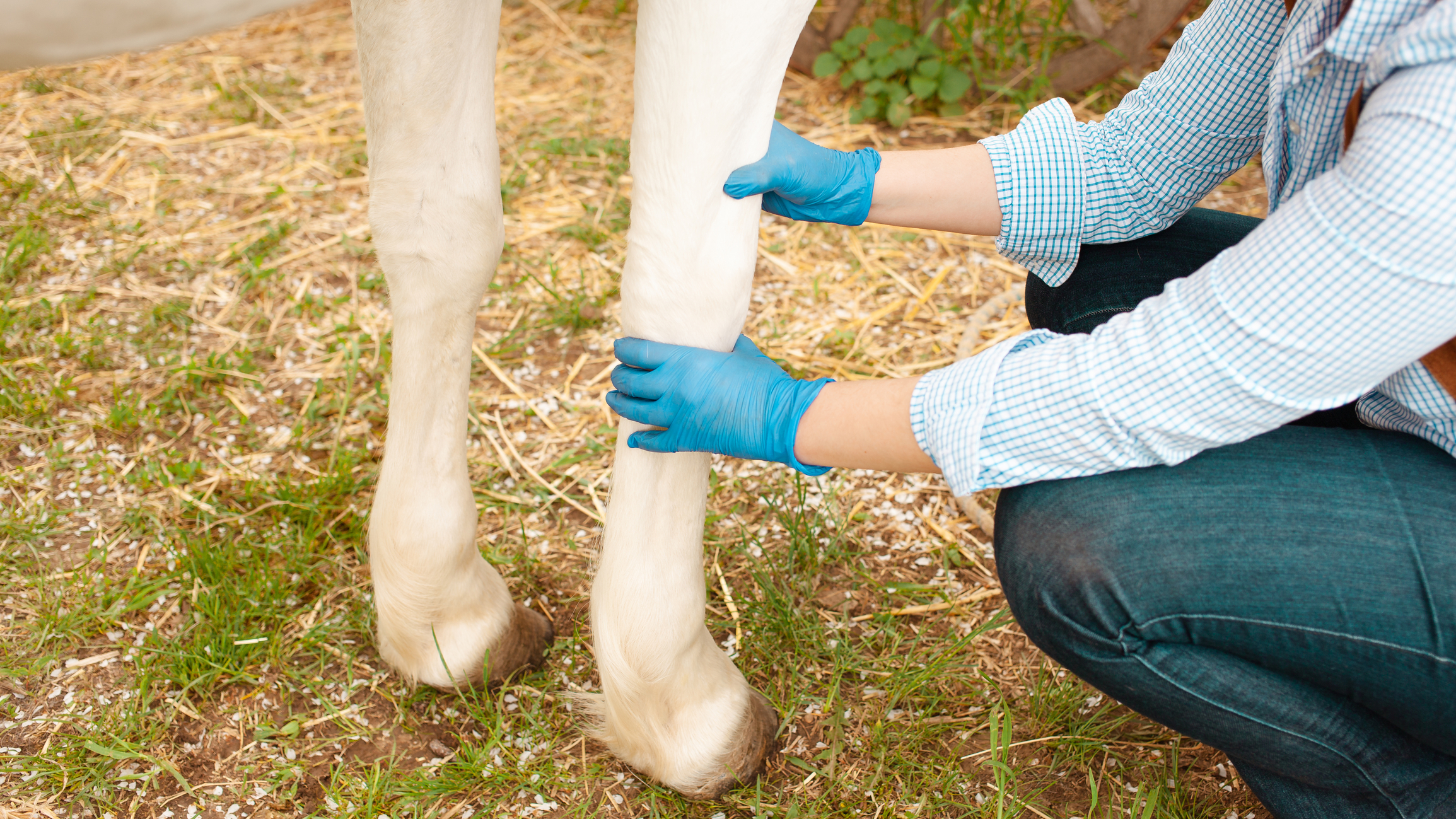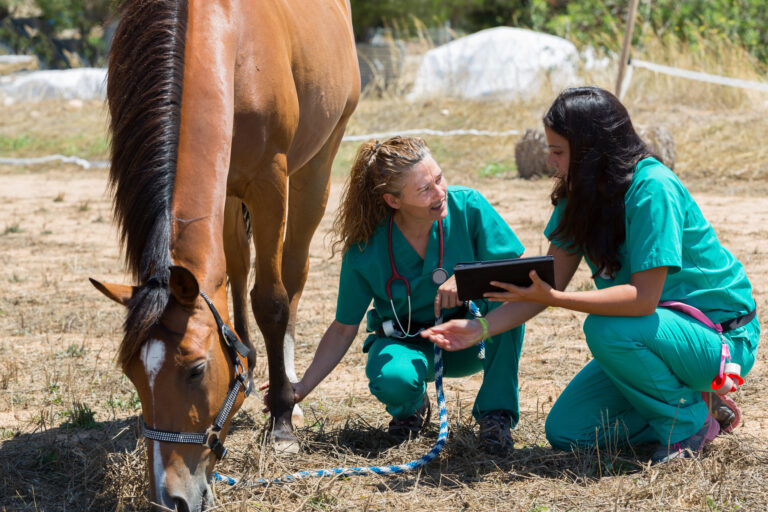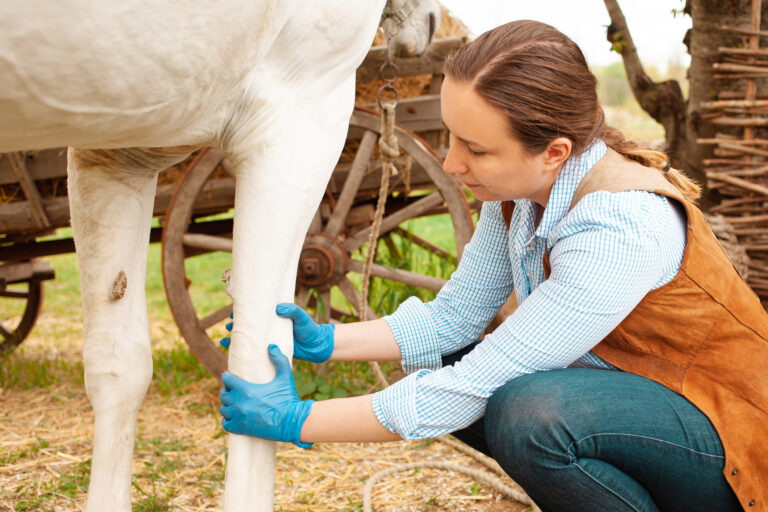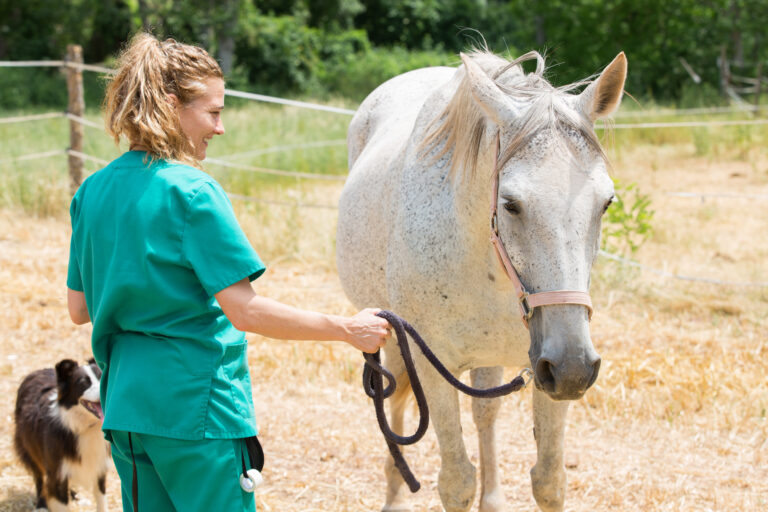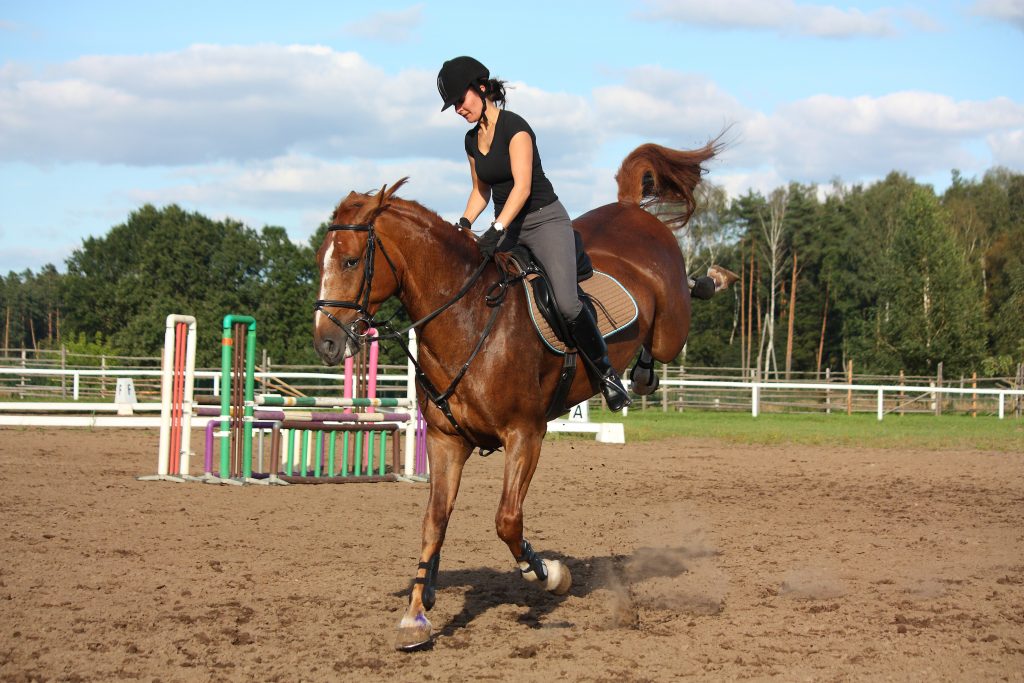From Swelling to Stride: A Guide to Diagnosing Horse Lameness Efficiently and Accurately
Lameness in horses is a common issue that can have many causes, from swelling to changes in how they move. The key to diagnosing lameness is observing the horse’s movement carefully and checking for any signs of pain, swelling, or uneven stride. Knowing what to look for helps you spot problems early and decide the right steps to take.
Your horse’s gait, weight shifting, and any visible swelling give clues about where the problem might be. Different types of lameness also show up in different ways, so a detailed observation combined with basic tests will guide you towards the right diagnosis and treatment. Understanding how lameness affects your horse will help you support its recovery and prevent further injury.
Key Takeaways
- Early observation of movement is crucial to identify lameness.
- Visible signs like swelling and weight shift point to specific issues.
- Correct diagnosis helps guide effective care and management.
Understanding Horse Lameness
Lameness in horses can show up as changes in how they move or stand. You will often notice differences in their stride or signs of discomfort. Early detection depends on spotting subtle signs like swelling or heat around joints and limbs.
What Is Lameness in Horses
Lameness means your horse is not moving normally because of pain or injury. It often shows in one or more limbs and can affect the horse’s stride or weight-bearing ability.
Pain causes your horse to alter its gait, which might look like a shortened or uneven stride. Swelling, heat, or oedema around joints or soft tissues often indicates an inflammatory process.
Lameness is a symptom, not a disease itself. It points to issues like tendon, ligament damage, or joint problems. Understanding these causes helps you decide when to seek veterinary care or adjust management.
Common Causes and Risk Factors
Many things can cause lameness in horses. Swelling from inflammation or injury is a key indicator. Conditions like tendonitis, ligament strain, or joint arthritis often cause pain and heat.
Breed and age affect risk. For example, older horses or those with conformation issues such as boxy hooves or long toes are more likely to develop problems. Poor farriery or uneven hoof trimming can also lead to lameness.
Nutrition plays a role in maintaining healthy bones and immune function, which supports healing. Weakness in the immune system or poor diet may slow recovery and increase the chance of recurring issues.
Recognising Early Signs
You should watch for changes in your horse’s movement or attitude. Early signs include limping, reluctance to bear weight, or uneven strides during walking or trotting.
Look closely for local swelling, warmth, or increased fluid (oedema) around joints or tendons. These signs indicate inflammation before more serious damage happens. Your horse might also show sensitivity to touch or discomfort when moving.
Early detection allows faster treatment. Monitor any stiffness or stiffness after rest, as this can signal underlying conditions. Observing your horse daily gives you the best chance to catch problems before they worsen.
For more detailed methods on diagnosing lameness, see this guide on Diagnosis and Management of Lameness in the Horse.
Initial Assessment of Lameness
You start by carefully observing the horse’s movement for irregularities in stride. Then, you check for any signs of pain, swelling, or heat that might help pinpoint the problem’s location. Your goal is to gather clear clues that help narrow down where and what might be causing the lameness.
Physical Examination
Begin by watching the horse walk and trot on a firm, straight surface. Notice any unevenness in stride, shortened steps, or head nodding. These signs indicate pain or discomfort in specific limbs.
Feel along the limbs and joints for heat or swelling. Heat often signals inflammation or injury, while swelling can be caused by fluid buildup or tissue damage.
Palpate tendons, ligaments, and joints gently but firmly. If the horse reacts with pain or withdraws, note the exact location. Check muscle condition and limb conformation as well.
A complete physical examination helps you collect detailed information that guides further testing.
Localising Lameness
To localise lameness, focus on which part of the limb the horse avoids bearing weight on. The horse shifts weight away from the painful limb during the stance phase of its stride.
Use flexion tests on different joints to provoke or increase lameness; this helps identify affected areas. Flex the fetlock, carpus, or hock for 30-60 seconds then observe the horse immediately after for worsening lameness.
Look for changes in stride length, foot placement, and weight distribution. These clues help you determine if the issue is in the foot, lower leg, or higher up the limb.
Identifying Swelling and Heat
Swelling may show as obvious lumps or subtle puffiness around joints, tendons, or soft tissues. You should compare both limbs to spot any differences.
Feel the swollen area for temperature changes. Increased heat usually means inflammation or infection, which can cause pain and lameness.
Be aware that some swelling is hidden beneath the skin, called oedema. It often feels soft and can spread along the limb.
Tracking swelling and heat assists you in deciding if more diagnostic imaging or tests are needed for a precise diagnosis.
For a detailed discussion on examining swelling and stride, see the guide on diagnosing horse lameness.
Diagnostic Approaches
To diagnose lameness in your horse accurately, you need to combine different methods. These vary from physical tests to imaging techniques that let you see inside bones and soft tissues. Each step gives you important clues about the injury’s location and severity.
Diagnostic Tests
Diagnostic tests help pinpoint the cause of lameness by observing how your horse moves and reacts. You start with a careful physical exam, watching your horse walk and trot on a hard surface. Look for uneven stride length, head nodding, or weight shifting. These signs show which limb might be painful.
You may also use nerve blocks. By injecting local anaesthetic around specific nerves, you can numb parts of the leg. If lameness stops after blocking, you know the pain is in that area. This narrows down your focus.
Other tests check for swelling or heat in joints, tendons, or ligaments. Palpation helps find tenderness. Some horses need exercise tests because pain only shows after movement. Accurate testing is key to deciding the next steps.
Radiographs and X-Rays
Radiographs (X-rays) show detailed images of your horse’s bones. They are essential for spotting fractures, bone chips, arthritis, or bone infections. You can see small changes in bone shape or density that might cause lameness.
X-rays are done by placing your horse in a specific position to target the area of concern. Several views might be taken for a full picture. Look for irregular edges, gaps, or swelling near joints.
While X-rays show bones well, they don’t show soft tissue injuries like tendon damage. For this, you need other imaging methods. Radiographs remain a basic and reliable tool to check for many causes of lameness.
Advanced Imaging: MRI and Bone Scan
For complex or hidden problems, advanced imaging is useful. MRI (Magnetic Resonance Imaging) gives a clear view of both bones and soft tissues like ligaments, tendons, and cartilage. It reveals swelling, tears, or bruising that X-rays can’t detect.
MRI helps when your horse has persistent or severe lameness without clear diagnosis from other tests. It requires sedation and special equipment, so it is more costly but very effective.
Bone scans involve injecting a small amount of radioactive material that collects in damaged bone areas. These areas light up on the scan, showing inflammation or injury not visible on X-rays. Bone scans are helpful for detecting stress fractures or hidden bone trauma.
Both advanced tests improve your chances of finding the exact cause of lameness, especially when other methods are inconclusive.
Flexion Tests and Their Role
Flexion tests involve bending specific joints or limbs for a set time and then observing your horse’s movement immediately after. These tests help stress certain areas to see if pain becomes more obvious.
For example, you might hold a horse’s knee or hock bent for 30 seconds then ask it to trot off. An increase in lameness suggests the joint tested may have a problem.
These tests are quick and simple but need to be done carefully to avoid injury. They help confirm suspicion when combined with other findings. Flexion tests often guide you about which joints or tendons to examine further using imaging or blocks.
Flexion tests are not definitive on their own but give useful information about potential problem areas in your horse’s limbs.
You can learn more about using diagnostic tests for equine lameness from detailed books like Diagnosis and Management of Lameness in the Horse.
Types of Lameness and Related Conditions
You will encounter various causes of lameness that come with distinct signs. These relate to soft tissues, bones, joints, or specific diseases affecting your horse’s movement and comfort. Understanding the exact problem helps focus your care and treatment efforts.
Soft Tissue Injuries
Soft tissue injuries often involve tendons and ligaments, such as the suspensory ligament and the deep digital flexor tendon. These structures support and flex your horse’s limbs, so damage can cause swelling, heat, and pain. You might notice varying degrees of lameness, often linked to the phase of stride where the leg bears weight or pushes off.
Lymphangitis is another soft tissue issue featuring swelling due to inflammation in the lymph vessels, usually seen along the limbs. It causes your horse’s leg to swell significantly and feel warm but may not always cause severe lameness.
Tendon or ligament inflammation is common after overuse or injury. Treatment varies but often includes rest, controlled exercise, and sometimes anti-inflammatory medication. Early diagnosis through careful observation and veterinary examination is key to managing soft tissue problems effectively.
Bone and Joint Issues
Bone injuries such as fractures or stress damage to the cannon bone or coffin bone severely impact lameness. These can cause sharp pain and visible swelling. Navicular syndrome affects the navicular bone and its associated structures, causing heel pain and an altered stride that often worsens with exercise.
Joint problems, including arthritis or stifle lameness, lead to stiffness and uneven gait. You may see swelling around the joint and a reluctance in movement. Inflammation inside joints often causes a subtle or persistent lameness that worsens over time.
Diagnosis involves palpation, observation of movement, and sometimes imaging like X-rays or ultrasound. Treatment may include rest, medication, joint injections, or corrective shoeing to reduce strain on affected bones or joints.
Specific Syndromes and Diseases
Laminitis is a painful condition affecting the hoof’s sensitive laminae, leading to severe lameness. Early signs include heat in the hoof and an unusual stance as your horse tries to relieve pressure. It requires immediate veterinary care to prevent permanent damage.
Equine Protozoal Myeloencephalitis (EPM) affects the nervous system, causing shifting leg weakness and asymmetrical lameness. It is harder to identify without specialised tests but must be considered when lameness is inconsistent or unexplained.
Other specific syndromes, like navicular syndrome mentioned earlier, or chronic conditions causing firm diffuse swelling, can develop over time. These syndromes often require ongoing management rather than cure.
Together, these types encompass most causes of lameness you’ll see in horses, so knowing the signs helps you take proper action sooner.
For more detailed information, you can consult Adams and Stashak’s lameness in horses, which provides thorough diagnostic guidance.
Management Strategies for Lameness
Managing lameness in a horse requires targeted action to reduce pain, support healing, and correct the underlying cause. You will need to focus on immediate relief, controlled rest, and long-term hoof care to improve your horse’s movement and comfort.
Immediate Response and Pain Relief
When your horse shows signs of lameness, the first step is to reduce pain and limit further injury. You should apply cold therapy, such as ice packs or cold water, on swollen areas for 15–20 minutes every few hours. This helps reduce inflammation.
Non-steroidal anti-inflammatory drugs (NSAIDs) can be used under veterinary advice to manage pain and swelling. Avoid walking the horse excessively; instead, keep it standing on soft ground to prevent stress on the limb.
Monitor the limb closely for heat, swelling, and changes in sensitivity. If the pain persists or worsens, you should contact your vet for a detailed examination and possible imaging.
Rehabilitation and Stall Rest
Controlled rest is key to healing most lameness cases. Stall rest limits movement but should be carefully managed to prevent stiffness.
During stall rest, you can hand-walk your horse briefly and gradually increase activity as advised by your vet. This helps maintain muscle tone without stressing the injured limb.
You will need to clean the stall regularly to keep the environment hygienic and comfortable. Use deep bedding to reduce pressure on joints.
Your vet may recommend physical therapy such as cold hose, massage, or laser treatment to speed recovery.
Corrective Shoeing and Trimming
Your farrier plays a vital role in managing lameness. Corrective trimming balances the hoof, reducing uneven stress on the leg and joints.
Shoeing with specialised shoes can provide support, cushioning, or control for abnormal limb function. Shoes with bars can help stabilise the hoof when needed.
In some cases, you may consider a neurectomy, a surgical procedure to remove nerve sensation. This is usually a last resort when other treatments fail.
Work closely with your farrier to adjust trimming and shoeing based on your horse’s progress and vet recommendations. Proper hoof care is essential for maintaining healthy stride mechanics.
For detailed diagnostic and management techniques, review guidance on diagnosis and management of lameness.
Prevention and Long-Term Care
Preventing lameness and managing its effects relies heavily on proper daily care and attention. Focus on balanced nutrition, regular hoof upkeep, and special considerations for older horses to help maintain soundness and comfort over time.
Equine Nutrition and Diet
Your horse’s diet should provide all essential nutrients without excess starch, which can trigger inflammation or laminitis, especially in horses with EMS (Equine Metabolic Syndrome). Hay is the main forage and must be of good quality. It supplies fibre and helps maintain gut health.
Work with an equine nutritionist to balance energy, protein, vitamins, and minerals. Vitamin A is vital for skin and hoof health. Avoid sudden diet changes; introduce new feeds gradually over 7–10 days.
Older horses often need lower starch and higher fibre diets. They may require supplementary feeds that are easy to chew and digest. Always provide fresh water and monitor weight to avoid obesity or weight loss.
Maintaining Hoof Health
Healthy hooves reduce the risk of swelling and lameness. Regular farrier visits every 6–8 weeks help maintain proper hoof shape and prevent uneven wear. Check hooves daily for cracks, thrush, or swelling around the fetlocks.
Keep the horse’s environment clean and dry to avoid bacterial infections that can cause painful swelling. Avoid overuse of long-term casts, as they can lead to circulation issues and soft tissue damage.
Trim hooves according to work level and terrain. For horses kept at grass, balance natural hoof wear with trimming to avoid excessive length or cracks. If swelling appears, limit exercise and consult a vet promptly.
Preventive Care for Older Horses
Aged horses need closer monitoring to prevent chronic lameness. Joint supplements, such as glucosamine and chondroitin, may help maintain cartilage health, but consult your vet before use.
Provide regular gentle exercise to maintain muscle tone and joint mobility. Tailor your horse’s workload to its comfort level and observe for signs of pain or stiffness.
Older horses benefit from being at grass when weather permits, as natural movement supports circulation and joint health. However, observe for swelling or heat around limbs, which could signal early lameness or injuries.
For long-term care, avoid multiple diagnostic nerve blocks unless necessary, as they may cause temporary swelling that can delay healing. If surgery isn’t an option, long-term support with bandages or splints might be required. For detailed strategies on swelling and lameness management, see Complications of Diagnostic Tests for Lameness.
Performance, Movement and Breeds
You need to understand how lameness affects a horse’s gait and how different breeds and disciplines show specific signs. This knowledge helps you spot issues early and tailor your approach depending on the horse’s use and breed traits.
Impact of Lameness on Gait
Lameness changes the way your horse moves, often in subtle ways. You might notice an uneven stride length or a disrupted rhythm at the walk, trot, or canter. For example, a lame limb might cause your horse to shift weight unevenly, making it move on three tracks instead of four.
Different phases of the stride can be affected. For example, during the action of the stride, the horse may avoid pushing off with the sore leg, resulting in a shortened step. The horse’s buck or sudden jumps might increase if pain worsens.
If your horse is used for specific activities, like a trotter or pacer in racing, lameness can reduce performance more noticeably. Swelling or stiffness may develop, especially in chronic cases, affecting how freely your horse moves.
Breeds and Discipline-Specific Considerations
Certain breeds show unique movement patterns that affect how lameness appears. For instance, an Arabian horse’s light, floating trot might make subtle lameness signs easier to see. In contrast, the Andalusian has expressive, collected movement that can hide minor irregularities.
Disciplines also matter. Performance horses used for dressage or jumping have different strain points compared to western horses, such as quarter horses. Your breed and training style shape the common lameness injuries you might encounter.
You should pay special attention to horses used in action-heavy sports or where specific gaits like the canter or trot are key. For example, pacing horses may show uneven rhythm early, while jumping horses will show changes in take-off force and landing.
Knowing your horse’s typical movement and breed traits helps you catch lameness signs before they impact performance seriously.
For more on this, see details at Equine Musculoskeletal and Lameness Exams.
Handling and Monitoring Horses with Lameness
Managing a lame horse requires careful attention to both physical support and detailed observation. You must use equipment correctly and regularly assess the horse’s condition to avoid worsening the injury or causing new problems.
Using Aids and Tack Appropriately
When working with a lame horse, choosing the right aids and tack is essential. Avoid harsh bits or tack that cause discomfort, as this can make the horse resist and worsen lameness. Use soft, clear aids to communicate gently, allowing the horse to move without added tension.
If swelling is present, especially in areas like the sheath, ensure any tack does not press on or irritate these spots. Regularly check for swelling or heat under saddles and girths. Break in new tack slowly to prevent unnecessary strain.
You may need to adjust exercise depending on the horse’s response to aids. For example, shorter sessions with light aids can help maintain muscle tone without overloading the limb.
Monitoring Progress and Readiness to Return to Work
Track your horse’s lameness by observing changes in stride length, limb movement, and swelling reduction. Keep records noting any improvements or setbacks. Pay close attention to pain signs while the horse bears weight, especially during turning or trotting.
Use regular low-impact exercise to test readiness but avoid heavy work until there is no signs of pain, swelling, or altered stride. Have a vet assess your horse’s condition before fully returning to work. This helps prevent further injury or chronic lameness.
If swelling around joints or in soft tissues like the sheath worsens, reduce workload and consult a professional. Early identification and management are key to a full recovery. For detailed guidance on diagnosis and treatment, refer to resources like this Diagnosis and Management of Lameness in the Horse.
Frequently Asked Questions
Understanding lameness in horses requires knowing how to measure severity and spot common signs. You also need to be aware of the examination process, specific grading levels, diagnostic tests, and costs involved.
How can one assess the severity of lameness using the 10-point scale?
The 10-point scale rates lameness from 0 (no lameness) to 10 (non-weight-bearing lameness). You observe the horse’s stride and weight bearing to assign a grade.
Grades 1–2 show subtle lameness, often detected only under certain conditions. Grades above 3 become easier to see as the horse’s limp worsens.
What are common signs of lameness in a horse’s front legs?
Signs in front legs include a shortened stride, head nodding while walking, and uneven weight distribution while standing. You may also see swelling or heat around the joints or tendons.
Look for a change in how the horse places its hooves when moving, as this can indicate pain or discomfort in the limb.
What steps are involved in a thorough lameness examination for horses?
You start with a history and visual inspection for swelling, heat, or muscle loss. Then watch the horse walking and trotting on different surfaces.
Palpate joints, tendons, and muscles to find pain points. Diagnostic nerve blocks and imaging might follow if the cause isn’t clear.
How much does a typical lameness examination for a horse cost in the UK?
Examination costs vary but typically range from £100 to £300. Prices depend on the vet’s experience, the tests needed, and whether advanced imaging is used.
Additional treatments or diagnostics will increase the total cost.
What is considered grade 3 lameness in equine patients?
Grade 3 lameness means the horse has an obvious lameness at a trot, visible immediately. The horse shifts weight away from the lame limb, but it can still bear weight.
This grade shows moderate discomfort affecting the horse’s performance.
What is the Churchill test and how does it aid in diagnosing equine lameness?
The Churchill test involves observing the horse’s movement while applying pressure or flexion to specific limbs. It helps pinpoint the location of pain causing the lameness.
This test often guides further examination and treatment. For more methods, see examination techniques from the visual exam and conformation guide.

